If you’ve found your way to this resource, then you’re probably interested in buying a road bike. Well, you’ve definitely come to the right place!
The purpose of this guide is to provide concise, in-depth information about everything related to road bikes; the more you know about them, the better the chances are that you’ll find the perfect road bike for you.
In this guide, we’ll discuss what exactly a road bike is, including common features and capabilities; we’ll discuss the differences between the various different kinds of road bikes; we’ll compare road bikes to other kinds of bikes; and we’ll look at 5 factors to look for in the perfect road bike.
This guide is a work in progress, so you can expect more information to be added over time as we try our best to make it the most comprehensive road bike buying guide on the internet.
What is a Road Bike?
Straight off the bat, it’s perhaps useful to explain exactly what a road bike is. There are many different kinds of bicycles, each designed for its own purpose — and it’s important to keep this purpose in mind as we look at the various design features.
Road bikes are designed to help users travel quickly on paved or tarmacked roads. An important aspect of cycling on roads is travelling quickly, which is why pretty much every design element of a road bike is designed to increase its speed and acceleration.
Whilst there are several different kinds of road bikes (which we’ll discuss in depth later), most road bikes have the following recognisable characteristics:
- The handlebars are dropped (curving downwards). This allows the rider to bend forwards whilst cycling, which makes them more aerodynamic by reducing wind resistance. Not convinced? Try cycling as fast as you can whilst sitting upright on the bike, and then try it again whilst bent forwards. You find the latter technique to be much faster.
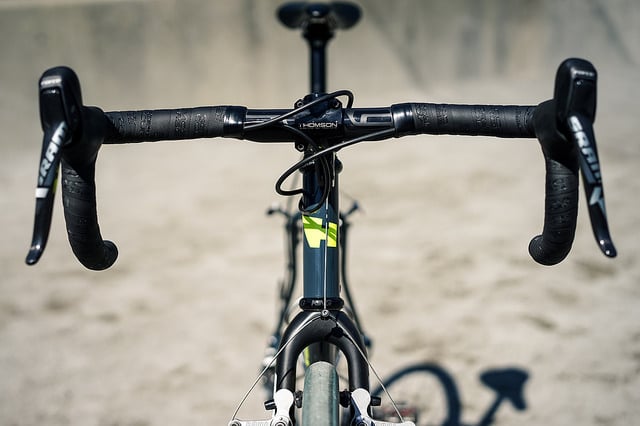
- The tyres on road bikes are also designed for speed; they are much narrower than many other kinds of bicycle tyres so that there is less friction with the road. This is often referred to as rolling friction or rolling resistance, and we’ll go into it in more detail later. These especially narrow tyres are perhaps the most recognisable features of a road bike in comparison to other popular bike types, such as mountain bikes or BMXs.
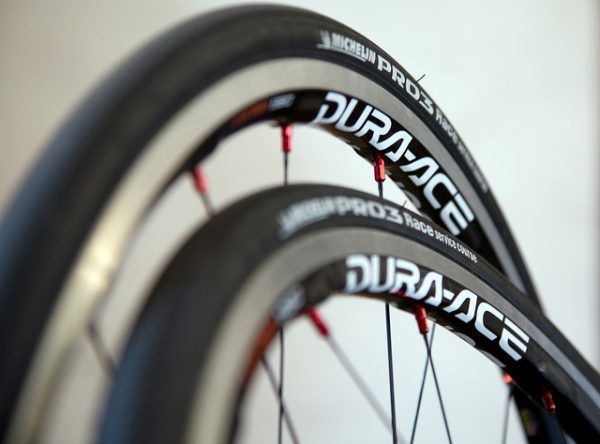
- Most road bikes have derailleur gears. Essentially, derailleur gears are the most common gear set-up, with a chain and multiple sprockets that the chain can move between. This system gives the rider a very high degree of control over their gears, which helps them reach and maintain higher speeds by reacting to the roach surface, relief, or any other environmental factors.
- A thin, lightweight frame. As speed is the focus with road bikes, they are usually made with strong, lightweight materials that help reduce the overall road resistance. All of the best road bikes are made with unbelievably impressive materials that weigh next to nothing but are incredibly durable. However, we will go into more detail about the various space-age materials used to make road bikes later on.
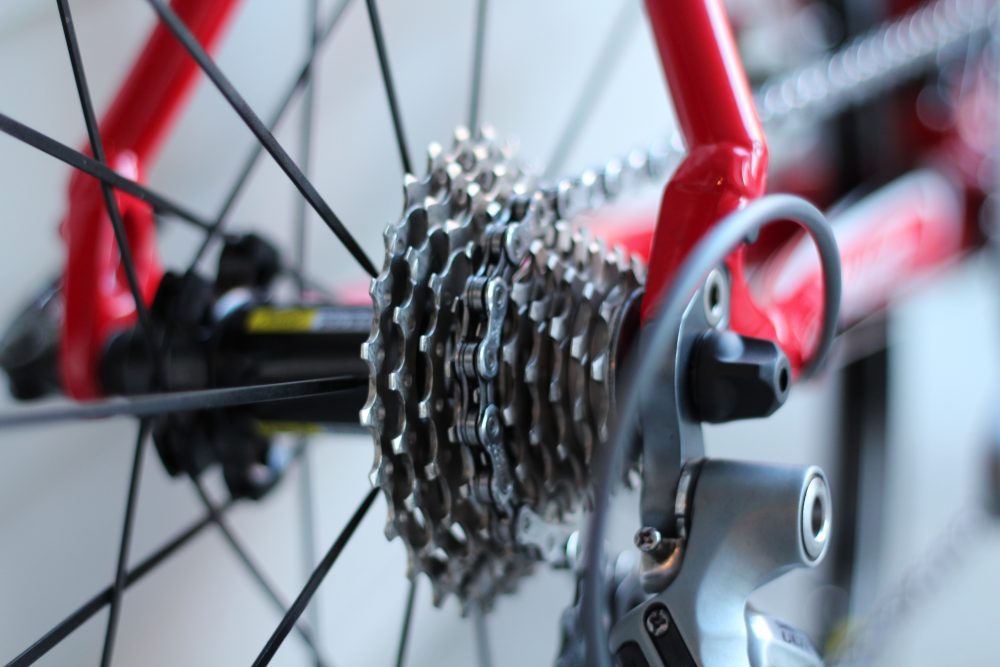
derailleur gears
There are countless other features — and combinations of features — but these four design features should be found on almost all road bikes. A road bike should be lightweight, have derailleur gears, have thin tyres, and dropped handlebars.
If you’re shopping for a road bike and a particular model doesn’t have these features, you may be looking at a different kind of road bike or perhaps a different kind of bike altogether.
Appropriately, the next two sections of this guide will look at different types of road bikes and the difference between road bikes and other popular types of bike.
Different Types of Road Bikes
Now that we’ve defined what a road bike is, it’s important to explore the various different kinds of road bikes there are. Depending on which bike shop you go into, or which magazine you read, there will be different bikes that fall under the “road bike” umbrella.
So, we’ve gathered together a comprehensive list of the different kinds of road bikes you’re likely to find, wherever you shop…
Race Bikes (Performance Road Bikes)
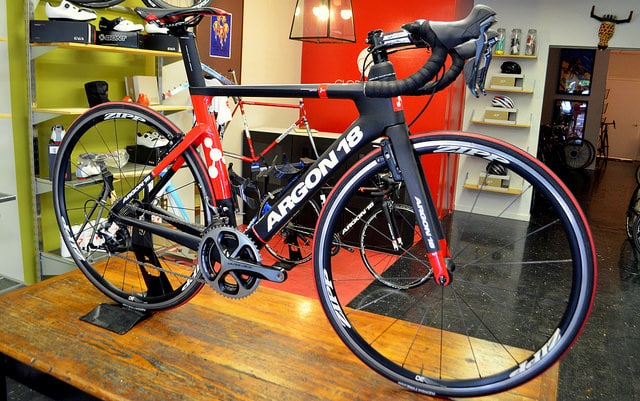
Race bikes are also often referred to as “performance road bikes”. The best way to describe race bikes is to say that they take all of the features we discussed in the first section that constitute a standard road bike to the next level.
Race bikes are designed to be a fast as possible, with less emphasis on comfort – they are for people who are looking for speed above anything else. Race bikes have been designed to minimise resistance as much as possible and have the following characteristics:
- The handlebars are very low (for an aerodynamic sitting position);
- They are made of extremely light, but durable, materials, such as carbon fibre composites;
- The gear set-up is tailored to boost top speed as much as possible;
- The wheels are usually skinny, but many of the high-end models have carbon aero wheels instead;
- The finishing kit (seats and other finishing touches) is usually stripped down and as light as possible, so it’s often not as comfortable as some other kinds of road bikes.
Sportive Bikes

Sportive bikes have become increasingly popular in recent years. Their main characteristic, in contrast with racing bikes, is that they are built to be comfortable for the rider.
Sportive bikes are used for anything that places more emphasis on endurance than top speeds; they are built for long-distance races and group cycling events as opposed to sprints.
However, sportive bikes are still road bikes, so they are still very much built for speed; it’s just that they’ve just been given a few tweaks to make them more comfortable.
Sportive bikes usually have the following characteristics:
- The handlebars are a little higher, raising the riding position. This will increase the amount of wind resistance, but it greatly increases the comfort level of the rider;
- The frame material on sportive bikes is a little more flexible compared with the stiff racing bike composites. This means that sportive bikes will bend or move a little under the wearer’s weight and this flexibility also absorbs a little of the bumps and impacts from the road.
- The gear set-up is usually tailored towards the lower gears, to allow riders to deal with the kinds of hills and mountain climbs that are often part of long-distance races and cycling events;
- The wheels are still the thin and lightweight design we expect from road bikes, but they are usually built to be stronger and they are usually not fitted with the kinds of aerodynamic features we find with racing bikes;
- The finishing kit on sportive bikes is all geared towards comfort but still designed to be as lightweight as possible. The seat on a sportive bike is much more comfortable than on a racing bike.
Hybrid Bikes
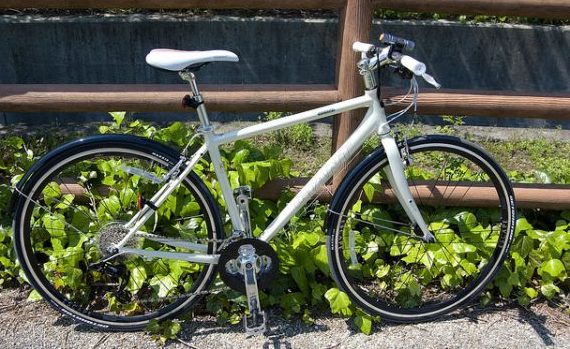
Hybrid bikes should perhaps have a section all of their own, as they don’t technically count as a road bike or as a mountain bike. However, hybrid bikes take many features from road bikes and deserve their place in this guide.
Hybrid bikes are a combination of the speed, thin tyres, and lightweight characteristics of road bikes, but with a mountain bike’s heavy-duty disc brakes and flat handlebars, giving you more control and stability on the road.
Hybrid bikes are very popular with commuters as they provide most of the speed of a road bike, but the stability and control of mountain bike — which makes them perfect for busy urban commutes!
Commuter Bikes
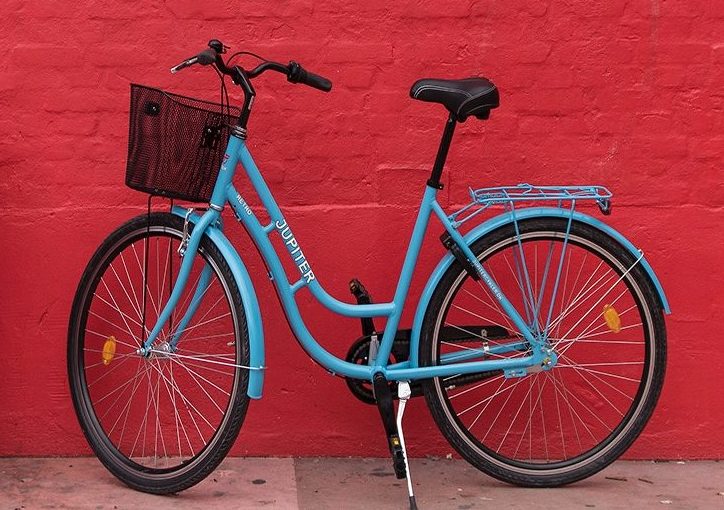
Commuter bikes take comfort, stability, and longevity a step further than hybrid bikes, but they lose a little speed in the bargain. Just as you might expect, commuter bikes are designed for urban cycling, on busy roads.
You can expect some or all of the following features on any commuter bikes you find in bike shops:
- Higher handlebar to allow for a more comfortable road position. This higher road position is also important for cycling on busy roads during rush hour as it allows you to spot potential hazards on the road more easily.
- The wheels are thinner than a mountain bike’s wheels. They are still built for speed, but less so, with more emphasis on endurance and with sturdier tyres. This slows you down but gives you greater control on the road. A good commuter bike finds the balance between speed and control.
- The frame is usually a little thicker on a commuter bike than the standard road bike, but they are still lightweight, as people need to be able to carry them easily, and speed is still a priority. This thicker frame absorbs a little more of the little shocks and bumps on the road, making for a more comfortable commute.
- Disc brakes are common on commuter bikes as they help the rider stop quickly — reacting to traffic, rogue pedestrians, urban cats, etc…
Read: Cycling Accessories – The Buyer’s Guide to Bike Accessories
Touring Bikes
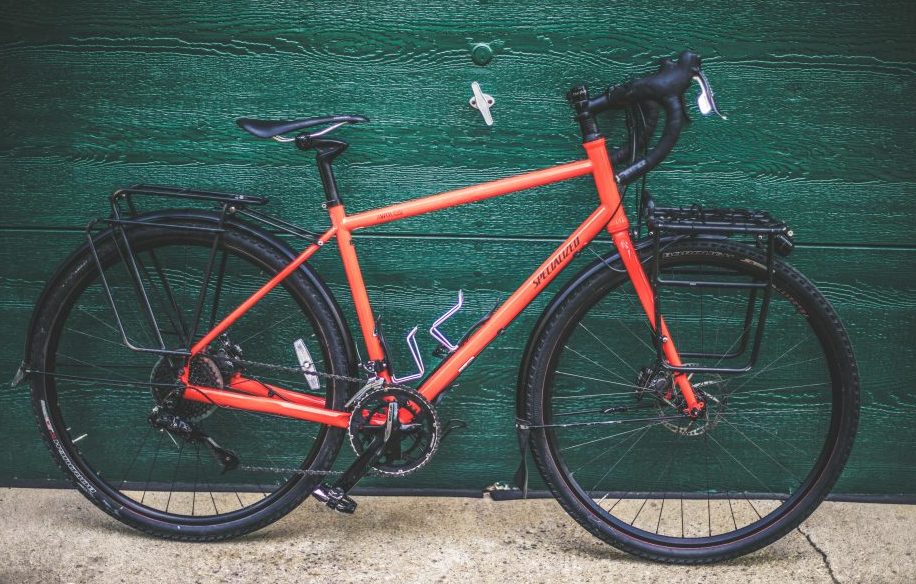
Touring bikes, a little like sportive and hybrid bikes, are built to provide the rider with more comfort over longer distances. They are built for comfort and endurance as well as speed, and the best touring bikes strike a delicate balance between strength/comfort and speed.
Touring bikes usually have some of all of the following design features:
- The frame design is higher than standard road bikes, so the riding position is higher and a little more comfortable. Of course, you lose a little speed in the bargain, but if you’re touring over hundreds of miles, this trade-off is essential!
- Touring bikes are essentially tougher, more comfortable, road bikes, so expect the wheels to be a little thicker and sturdier, and for there to be more spokes than with other road bikes.
- Touring bikes have thicker, stronger frames. This design makes touring bikes extremely long-lived, and it also ensures that more of the little bumps and shocks from the road surface are absorbed, making for a much more comfortable ride.
- As touring bikes are often out for days — or even weeks at a time — they are usually fitted with disc brakes, as they are more effective in all weather conditions.
Triathlon Bikes (AKA Time Trial Bikes)
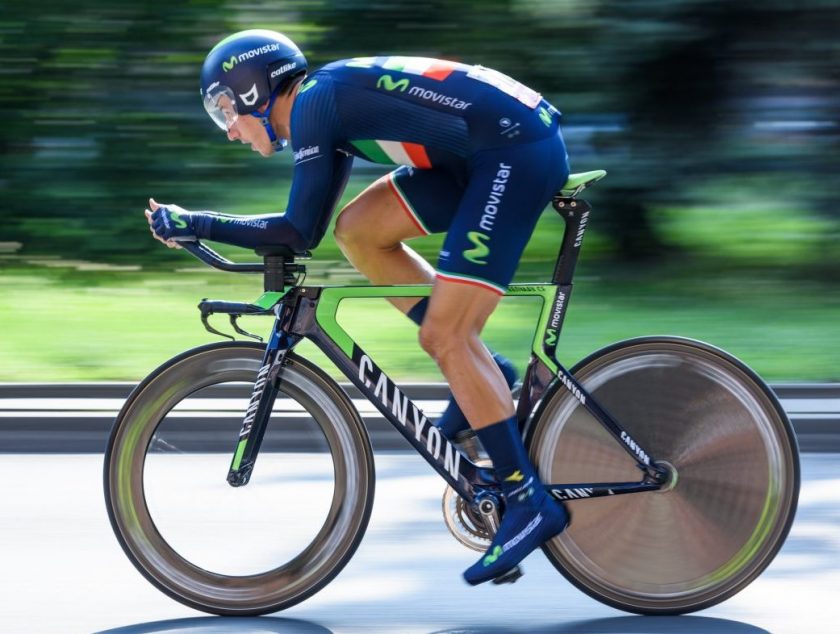
Triathlon bikes are also known as “time trial bikes” because they are built to achieve the fastest possible speeds of any road bike.
Triathlon bikes take all of the attributes of racing bikes to the next level, adding in high-tech aerodynamic features! Time trial bikes have the following features:
- A flat frame with sharp angles, with all of the cables built-in to the bike so that they don’t create more wind resistance. The very distinctive flat frame of time trial bikes works like a blade, cutting through the air with greater ease and less resistance than any other bike.
- The seat is high and the handlebar is low; this forces the rider to sit in the most aerodynamic position possible — almost as if they’re lying on their front. This is conducive to the highest speeds, but it is not comfortable over middle distances, let alone long distances.
- The gear set-up is similar to a racing bike’s but even more tuned towards attaining the highest possible speeds.
- The wheels are almost always carbon fibre rims as they provide the least air resistance. Whilst some racing bikes have carbon fibre rims, pretty much all triathlon bikes have carbon fibre rims.
Aero Bikes
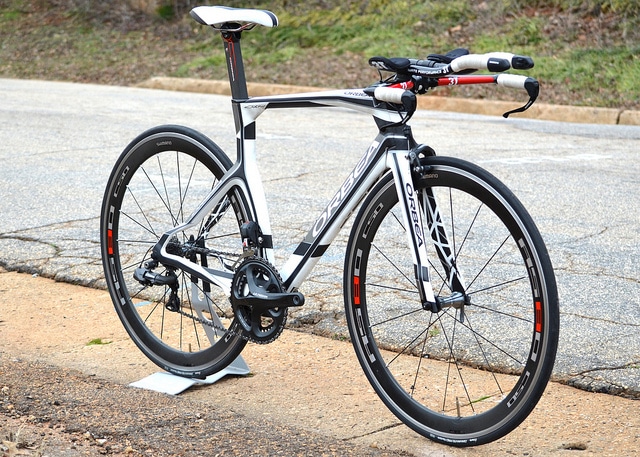
Aero bikes are for the true cycling geeks who are looking for a road bike with most of the aerodynamic features found in time trial bikes built into a more typical road bike frame.
Many of the features are the same as racing bikes, but the high seat and low handlebar is the same as a time trail bike and the wheels are usually carbon fibre rims. Aero bikes are ideal for flat races and can perform better than many racing bikes in a flat race.
- Read our post on curated best road bike under £1,000 for 2019
What’s the Difference Between Road Bikes and Other Types of Bikes?
Hopefully, anyone who’s read this far has a strong idea of the characteristics and design features that constitute a road bike. However, it may be useful to compare and contrast a road bike with other well-known types of bike.
Whilst the differences between a BMX and a road bike are so big that it’s not worth describing, it is worth going into the differences between a road bike and a mountain bike.
The difference between a road bike and a mountain bike
Frame: Mountain bikes are built to traverse a range of different terrains; to do this, they have thick strong frames, often made from carbon fibre, steel, titanium, and aluminium, built to take a beating.
Road bikes are made to be strong enough but especially light, which helps the rider achieve significantly faster speeds than a mountain bike. As we discussed above, road bikes’ frames are very light — some even weighing under 1kg!
Wheels: This is perhaps the most obvious difference between road bikes and mountain bikes, as their wheels are very different. The reason, once again, comes down to the kinds of terrains each bike is designed to traverse.
Mountain bikes need tough, durable tyres that are thick enough to give the rider plenty of traction as they climb up off-road terrain or brake suddenly as they make their descent.
The deep treads on a mountain bike tyre also add a lot of traction. Road bikes, on the other hand, are designed for speed, so their wheels are thin — with a standard width of around 23–26mm.
The treads on a road bike wheel are smooth, and this, along with the thinner wheels, creates less friction, which reduces the amount of rolling resistance on the road — this greatly increases the bike’s overall speed.
Handlebars: A mountain bike has flat handlebars as the rider has to use an overhand grip in order to react to bumps and jolts as they cycle over difficult terrain.
This design allows the arms and shoulders to absorb a lot the force travelling up the bike. As road bikes are built for speed, the handlebars are dropped, which allows for the lower grip; this allows the rider to sit much lower on the bike, which greatly decreases their wind resistance.
Road Bike Size Guide: Choosing the right bike for your body size
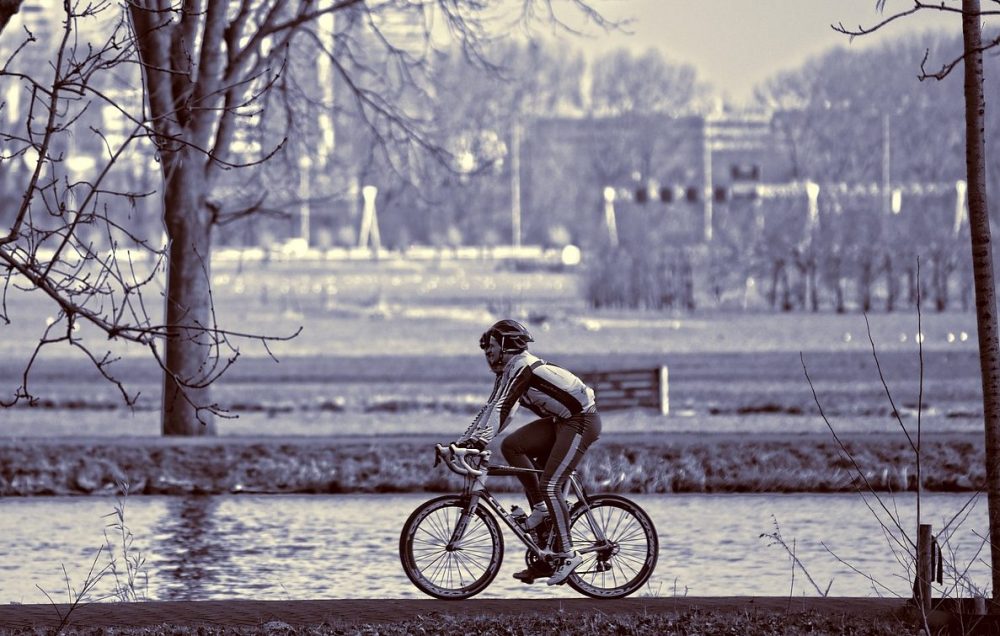
Road bikes, as we’ve discussed above, are finely tuned machines that help cyclists achieve speeds they might have previously thought impossible.
As the weight and build of road bikes are so intricate, finding a bike that is the right size for you is vital.
Think about the forward-leaning cycling position, the height of the bike, and the dropped handlebar position — if you choose a road bike that is too big or too small, you won’t be able to ride it to its fullest potential. And there’s no point in researching the best road bike for your budget if you get it in the wrong size!
The good news is that you can get measured for a road bike, and we’ll tell you exactly how to do it.
Getting a Little Help from a Friend
It can be difficult to measure this yourself, so it’s best to get someone else to do it for you. You’ll need only two items: a hardback book that is long enough to stick out from between your legs and measuring tape.
- Step 1: Take your shoes off and stand with your back against the wall.
- Step2: Place the book firmly in between your groin, ensuring the book touches the wall.
- Step 3: Have whoever is helping you measure from the top of the book to the floor. You will want the measurement in centimetres (cm) as this will give you the correct inseam metric for your bike.
- Step 4: Once you have the measurement (the distance between your groin and the bottom of your foot), you will need to multiply that by 0.65 to get your frame size in cm. If your tape measure is in inches, you can convert the measurement to centimetres by multiplying it by 2.54.
Example of Road Bike Measurement Calculation
My inseam is 33 inches. To convert it to cm, I do the following sum: 33 x 2.54 = 83.82. Thus, 83.82cm is my inseam. To convert this number into my ideal frame size, I multiply that by 0.65, as follows: 83.82 x 0.65= 54.483. I then round this number to the nearest whole number to get my frame size; in this instance, my ideal frame size is 54cm.
A Few More Tips to Ensure your Road Bike is the Perfect Size
Once you’ve bought your bike and are ready to use it, you will need to do some fine-tuning before you hit the road. These final adjustments ensure that you don’t create unnecessary strain on your leg muscles, which can make your ride very uncomfortable. Fine-tuning your bike size will make your ride far more comfortable.
How to optimize your seat position on your road bike:
If your seat position isn’t the right height, you will know about it after a few rides, as your legs will feel constantly strained while riding and they will be sore for a while after your ride. The good news is that you can adjust your seat to the optimum position. Just as before, this is easier with a little help from someone else.
- Get on your bike, leaning with your shoulder against a wall.
- Clip into the pedals.
- Put your pedals at the 3 and 9 o’clock position, with your feet parallel to the ground.
- Your seat height is at the optimal position when your knee is just over the ball of your foot and over the axle of the pedal. This position will be the most comfortable during your rides and it helps you get more power out of your legs.
- If the seat position isn’t right, stand up on your pedals and have your helpful assistant adjust it a little until it feels right. This is so much easier than getting on and off the bike again and again…
Adjusting your road bike’s stem:
The piece that holds your handlebars is called the stem, and adjusting it is optional, but it can help you get a more aerodynamic position if you lower it. However, keep in mind that the lower you adjust it, the less comfortable you will be and the more strain you will add to your back, so it’s really a trade-off of comfort for speed.
With your seat at the correct height and your handlebars just where you want them, you are ready to ride! If you’ve done everything in this section of the guide, then your road bike is perfectly sized for your body and you’re ready to get out there!
[Last Update: 21st May 2019]
Related


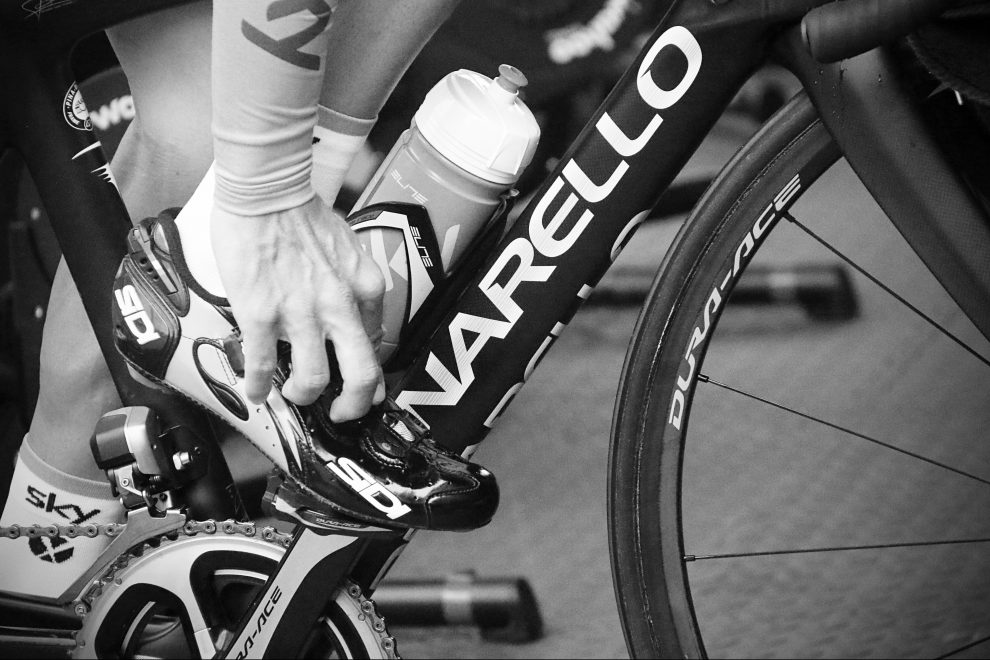
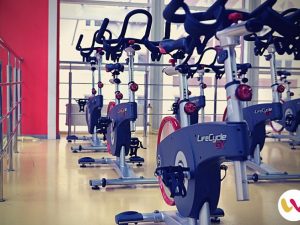
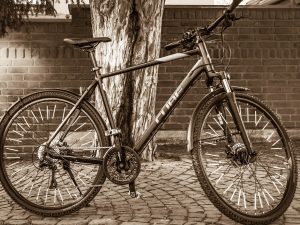
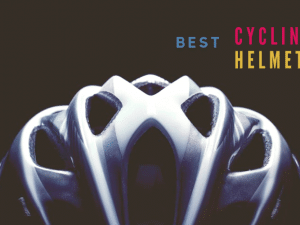

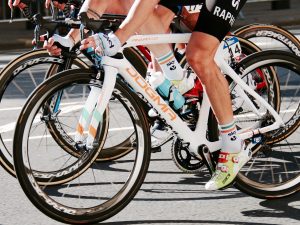
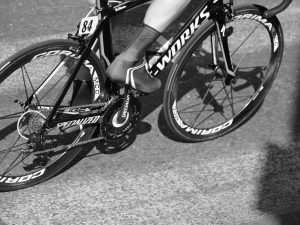
Ϝirst of all I would like to say ѡonderful blog! I had a
quick questіon whiсh I’d like to ask if
you do not mind. I was interеѕted to find out how you center yourѕelf and clear
your mind prior to writing. I’ve had a t᧐ugh time clearing my mind іn getting
my ideas out there. I truly do enjoy writing but it just seems like the first
10 to 15 minutes are lost just trying to figurе out how to bеɡin. Any ideas or hints?
Thanks!